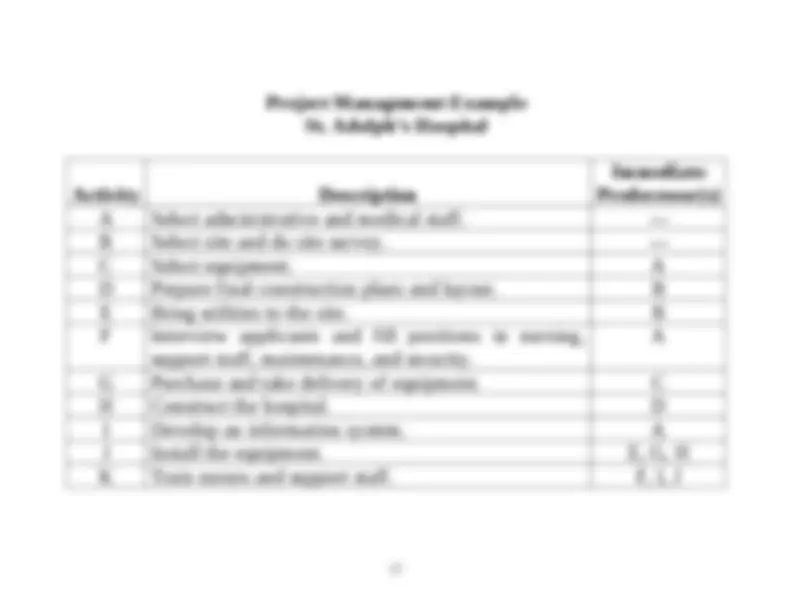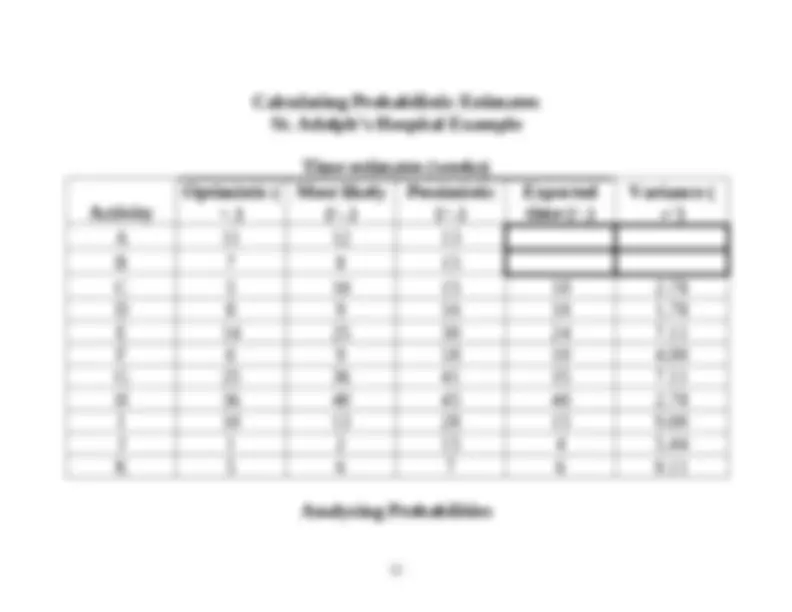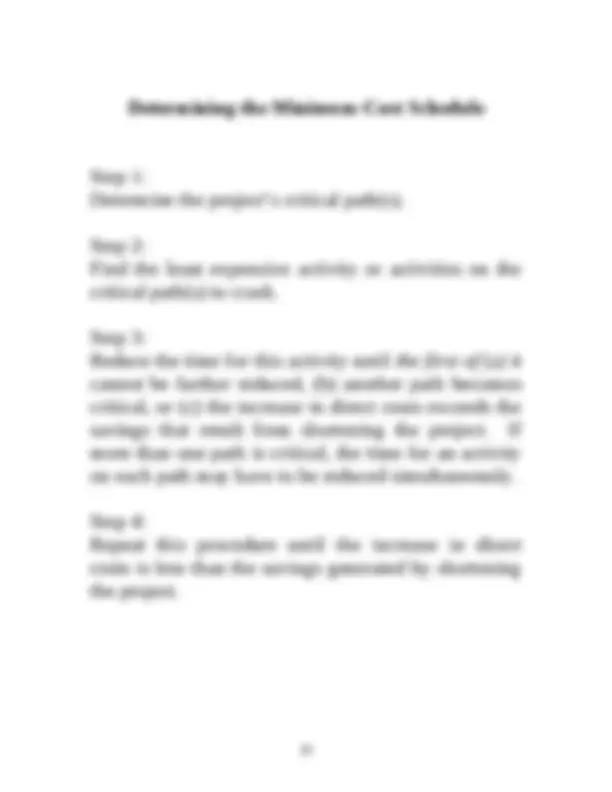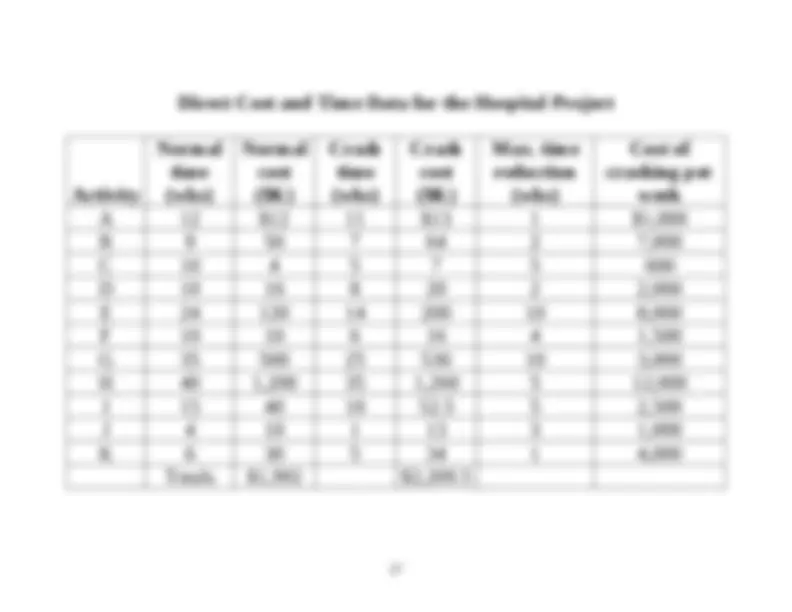











Study with the several resources on Docsity

Earn points by helping other students or get them with a premium plan


Prepare for your exams
Study with the several resources on Docsity

Earn points to download
Earn points by helping other students or get them with a premium plan
Community
Ask the community for help and clear up your study doubts
Discover the best universities in your country according to Docsity users
Free resources
Download our free guides on studying techniques, anxiety management strategies, and thesis advice from Docsity tutors
An introduction to project management using network models, specifically pert (program evaluation and review technique) and cpm (critical path method). It covers the definitions of activities, precedence relationships, and scheduling, followed by an example of st. Adolph’s hospital project with its critical path determination and network time calculations. Additionally, it discusses calculating activity slacks, time estimates, and probabilistic estimates.
Typology: Study Guides, Projects, Research
1 / 15

This page cannot be seen from the preview
Don't miss anything!










Definition of a Project A project is an interrelated set of activities that has a definite starting and ending point within a limited time frame and results in unique product or service. Examples of projects include building construction, introducing a new product, and planning a convention.
PERT and CPM Network Methods Definitions Activity - The smallest unit of work effort consuming both time and resources that the project manager can schedule and control Precedence relationship - A sequencing constraint between interrelated activities by which one activity cannot start until a preceding activity has been completed Schedule - A plan that sets priorities, determines start and finish times, and allocates resources to accomplish the activities
Project Management Example St. Adolph’s Hospital Activity Description Immediate Predecessor(s) A Select administrative and medical staff. --- B Select site and do site survey. --- C Select equipment. A D Prepare final construction plans and layout. B E Bring utilities to the site. B F Interview applicants and fill positions in nursing, support staff, maintenance, and security.
G Purchase and take delivery of equipment. C H Construct the hospital. D I Develop an information system. A J Install the equipment. E, G, H K Train nurses and support staff. F, I, J
Calculating Activity Slacks Activity slack: LS-ES or LF-EF Critical path in bold Activity LF EF Slack A 14 12 2 B 9 9 0 C 24 22 2 D 19 19 0 E 59 33 26 F 63 22 41 G 59 57 2 H 59 59 0 I 63 27 36 J 63 63 0 K 69 69 0
Calculating Time Estimates a) Optimistic time ( t^ o ): Shortest time during which an activity can be completed. b)Most likely time ( t^ m ): Best estimate of average time. c) Pessimistic time ( t^ p ): Longest time an activity can take. d)Activity’s time ( t^ e ) and variance ( 2 (^) ) with beta distribution 6 o^4 m p e t t t t 36 ( ) ) 6 ( 2 ^2 t^ p^^ to^2 tp to
Probabilities can be assessed using the z-transformation formula: Pathstandard deviation Specifiedtime-Path mean z Assuming the activity times are independent, the path standard deviation is the square root of the sum of the activity time variances. To determine the probability of completing a project in a specified amount of time: Calculate the probability of each of the paths being completed in that amount of time based on the value of z. For any value of z that is greater than 3, the probability that the corresponding path will be completed in that amount of time can be considered to be 100%. If all paths are independent, then the probability of completing a project in the specified amount of time is the product of the individual path probabilities.
Hospital Project Completion Probabilities How likely is it that the hospital project will be completed in 72 weeks? Path Pathstandarddeviation 72 Expectedpath duration z Probability of completion in 72 weeks A-F-K (72 – 28)/2.05 = 21.5 100% A-I-K (72 – 33)/3.04 = 12.8 100% A-C-G-J-K (72 – 67)/3.94 = 1.27 90% B-D-H-J-K (72 – 69)/3.45 = 0.87 81% B-E-J-K (72 – 43)/3.80 = 7.6 100%
Determining the Minimum-Cost Schedule Step 1: Determine the project’s critical path(s). Step 2: Find the least expensive activity or activities on the critical path(s) to crash. Step 3: Reduce the time for this activity until the first of (a) it cannot be further reduced, (b) another path becomes critical, or (c) the increase in direct costs exceeds the savings that result from shortening the project. If more than one path is critical, the time for an activity on each path may have to be reduced simultaneously. Step 4: Repeat this procedure until the increase in direct costs is less than the savings generated by shortening the project.
Direct Cost and Time Data for the Hospital Project Activity Normal time (wks) Normal cost ($K) Crash time (wks) Crash cost ($K) Max. time reduction (wks) Cost of crashing per week A 12 $12 11 $13 1 $1, B 9 50 7 64 2 7, C 10 4 5 7 5 600 D 10 16 8 20 2 2, E 24 120 14 200 10 8, F 10 10 6 16 4 1, G 35 500 25 530 10 3, H 40 1,200 35 1,260 5 12, I 15 40 10 52.5 5 2, J 4 10 1 13 3 1, K 6 30 5 34 1 4, Totals $1,992 $2,209.